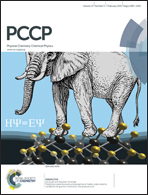Carbon nanoscroll from C4H/C4F-type graphene superlattice: MD and MM simulation insights†
Abstract
Morphology manipulation opens up a new avenue for controlling and tailoring the functional properties of graphene, enabling the exploration of graphene-based nanomaterials. Through mixing single-side-hydrogenated graphene (C4H) with fluorinated graphene (C4F) on one single sheet, the C4H/C4F-type graphene superlattices can self-scroll at room temperature. We demonstrate using molecular dynamic (MD) simulations that different proportions, sizes, directions of hydrogenation and fluorination, and geometry of graphene have a great influence on the self-scrolling of superlattices into a variety of well-defined carbon nanoscrolls (CNSs), thus providing a controllable approach to tune their structures. Based on molecular mechanics (MM) simulations, the CNSs bear more than eight times the radial pressure than that of their multiwalled carbon nanotube (MWNT) counterparts, and an excellent radial elasticity of CNSs is also shown. Compared with conventional CNSs, these novel CNSs are endowed with more ample and flexible heterogeneous structures due to the on-demand hydrogenation and fluorination. Besides, this work provides a feasible route to achieve the necessary electronic and optical changes to be applied in graphene device applications.


 Please wait while we load your content...
Please wait while we load your content...